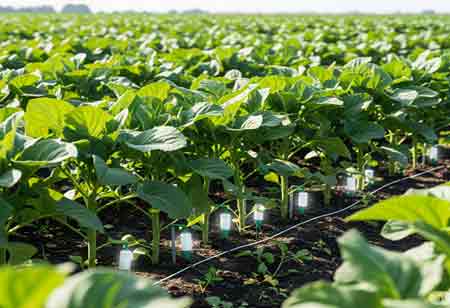Thank you for Subscribing to Agri Business Review Weekly Brief
The Environmental Promise of Smart Fertilizers
The science behind controlled-release fertilizers represents a paradigm shift in nutrient management. The game has indeed changed, and the future looks remarkably intelligent.

By
Agri Business Review | Tuesday, July 08, 2025
Stay ahead of the industry with exclusive feature stories on the top companies, expert insights and the latest news delivered straight to your inbox. Subscribe today.
Fremont, CA: For centuries, farmers have used fertilizers to enhance crop yields; however, their inefficiency often results in nutrient loss, economic waste, and environmental harm. Enter the era of "smart fertilizers," a leap forward in agricultural technology, with controlled-release products at its forefront. These innovative solutions are not just about adding nutrients; they're about delivering them precisely when and where plants need them most, fundamentally changing the game for sustainable agriculture.
The Ingenuity of Controlled-Release Mechanisms
Controlled-release fertilizers (CRFs) represent a significant advancement in agricultural science, offering precise control over the rate at which nutrients become available to plants. This controlled release is primarily achieved through two core scientific strategies: coated fertilizers and matrix-based fertilizers.
Coated fertilizers utilize a protective shell to regulate nutrient diffusion. Among the most common forms are polymer-coated urea (PCU) and sulphur-coated urea (SCU). In PCU, soluble urea granules are enveloped in a thin layer of polymer resin. The release rate of nutrients is governed by the thickness and permeability of this coating, with environmental factors such as soil temperature and moisture influencing the diffusion rate. Water penetrates the coating, dissolves the urea inside, and allows the nutrients to diffuse out through microscopic pores in the polymer. SCU, on the other hand, features a coating of elemental sulfur. While this method provides less precision than polymer coatings, it relies on microbial degradation and physical cracking of the sulfur layer to release nutrients.
In some cases, CRFs incorporate multi-layer coatings or hybrid systems—such as a polymer overlay on a sulfur base—to create more tailored nutrient-release profiles. These may include biodegradable materials to enhance environmental sustainability. The performance of coated fertilizers depends heavily on the chemical and physical characteristics of the coating. Scientists adjust polymer chain length, cross-linking density, and the inclusion of additives to engineer specific degradation timelines suited to particular crops and conditions.
Matrix-based fertilizers adopt a different approach by embedding nutrients directly within a solid matrix. As the matrix breaks down or dissolves, nutrients are released gradually. For instance, resin-impregnated fertilizers entrap nutrients within a resin that decomposes over time in the soil. Alternatively, organic matrix fertilizers utilize biodegradable organic materials—such as compost or plant-derived products—to encapsulate nutrients. As the organic matter naturally decomposes, it releases the nutrients while simultaneously contributing to soil health. The release dynamics of matrix-based fertilizers are influenced by environmental factors, including microbial activity, soil pH, and temperature, making them exceptionally responsive to varying soil conditions.
The Game-Changing Benefits of Smart Fertilizers
Scientific advancements in CRF technology have yielded a range of significant benefits for both agriculture and the environment. By aligning nutrient release with plant uptake patterns, CRFs enhance nutrient use efficiency (NUE), ensuring that a greater proportion of applied nutrients is absorbed by crops rather than lost to the environment. This synchronization leads to higher yields with reduced fertilizer input. Environmentally, CRFs mitigate the leaching of nitrates into groundwater and reduce phosphorus runoff, resulting in cleaner waterways and healthier ecosystems. Lower emissions of nitrous oxide—a potent greenhouse gas—support broader efforts to mitigate climate change. From an operational standpoint, CRFs reduce the frequency of fertilizer applications, thereby lowering labor, fuel, and equipment costs for farmers. The consistent nutrient availability throughout the growing season also promotes healthier plant development, improves crop quality, and boosts overall yields.
The evolution of smart fertilizers continues to advance, with future innovations poised to enhance their precision, sustainability, and responsiveness significantly. In parallel, there is growing emphasis on the use of biodegradable and bio-based materials, derived from renewable sources, to minimize environmental impact. The future of smart fertilizers is likely to be shaped by their integration with real-time soil and plant sensing technologies, allowing for hyper-localized, data-driven nutrient application systems that respond to changing field conditions.





